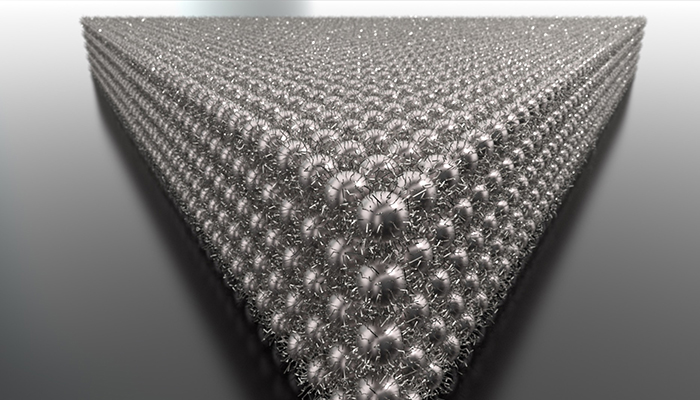Lawrence Livermore researchers are working to make better electronic devices by delving into the way nanocrystals are arranged inside them.
Nanocrystals for optoelectronics
Colloidal semiconductor nanocrystals are promising building blocks for large-area, flexible thin film optoelectronic devices, including solar cells, photodetectors, and light-emitting devices, due to their size-tunable optical properties and ability to be integrated into devices with low-cost solution processing. Colloidal nanocrystals can be deposited from their suspension solvent to solid substrates by using solution-based casting methods (such as spin-coating, dip-coating, spray coating).
Formation of highly ordered colloidal crystals is important to efficiently transport charge carriers between nanocrystals, since previous research has suggested that there is a strong correlation between the degree of order and carrier delocalization length that could determine charge carrier mobility.
Probing silver nanocrystal superlattices
We demonstrated the electric field-driven silver (Ag) nanocrystal superlattice self-assembly by using an electrophoretic deposition (EPD) method. The Ag superlattices have a uniform equilateral triangular shape, and the grazing-incidence small-angle scattering (GISAXS) pattern exhibits distinct diffraction spots, indicating formation of well-ordered superlattices. Our proposed mechanism for EPD shows Ag nanocrystals—charged through charge transfer with surface ligands, surrounding solvents, or other nanocrystals—respond to the applied electric fields and become neutralized on the electrode surface, accumulate on the electrode, and nucleate and grow to superlattices.
With a size-dependent electrophoretic mobility, EPD is able to yield more ordered nanocrystal arrays by selecting the size of nanocrystal entering the array, compared to the conventional solution evaporation methods.
Upcoming nanocrystal innovations
With successful formation of Ag metal nanocrystal superlattices, we have extended our capability to ordered colloidal semiconductor nanocrystal arrays. We have synthesized lead sulfide (PbS) nanocrystals as a model material and investigated the effects of surface chemistry on the formation of superlattice arrays by varying surface ligands. We will further elucidate the correlation between the degree of order and charge carrier transport.
We are developing a new nanocrystal solar cell fabrication process that has the potential to generate high-efficiency solar cells and establish a platform to systematically study the interplay between nanocrystal surface chemistry, order, and device efficiency. Development of such cells is an important step in reducing the cost of solar electricity.
Publications
Y. Yu, D. Yu, B. Sadigh, C.A. Orme, Space- and time-resolved small angle X-ray scattering to probe assembly of silver nanocrystal superlattices, Nat. Communications 9, 4211 (2018).
Y. Yu, D. Yu, C.A. Orme, Reversible, Tunable, Electric-Field Driven Assembly of Silver Nanocrystal Superlattices, Nano Lett. 17, 3862 (2017).
People
Learn more about nanocrystal solar cells
- Nanowire arrays could improve solar cells (LLNL news, August 8, 2019)
- Probing silver nanocrystal superlattices (Physical and Life Sciences news, November 30, 2018)
- Nanocrystals arrange to improve electronics (LLNL news, October 25, 2018)






